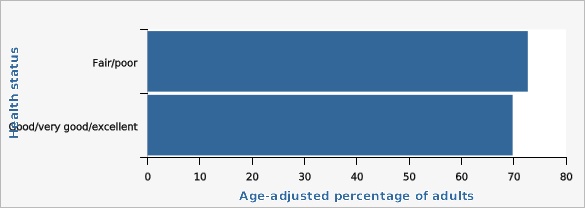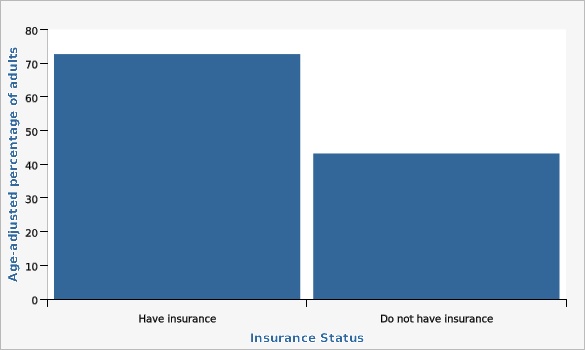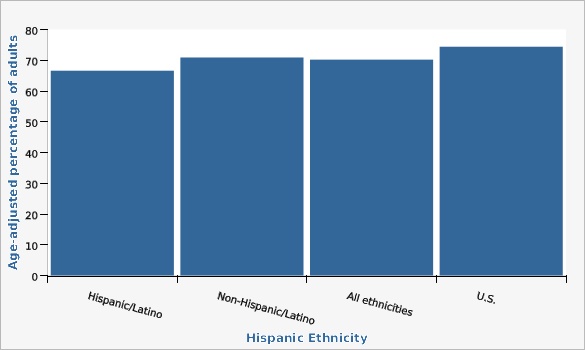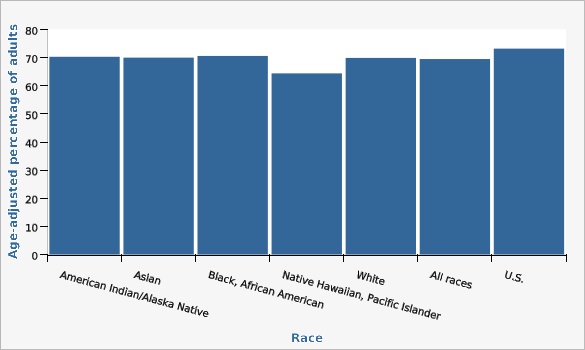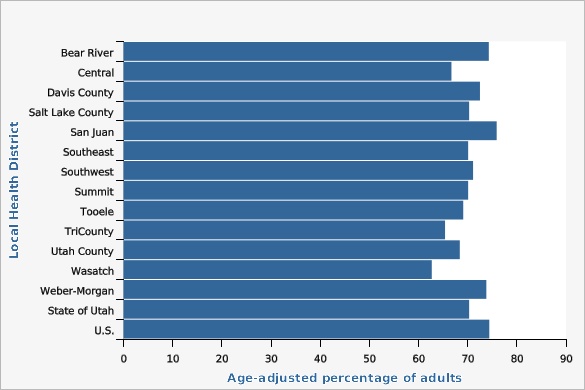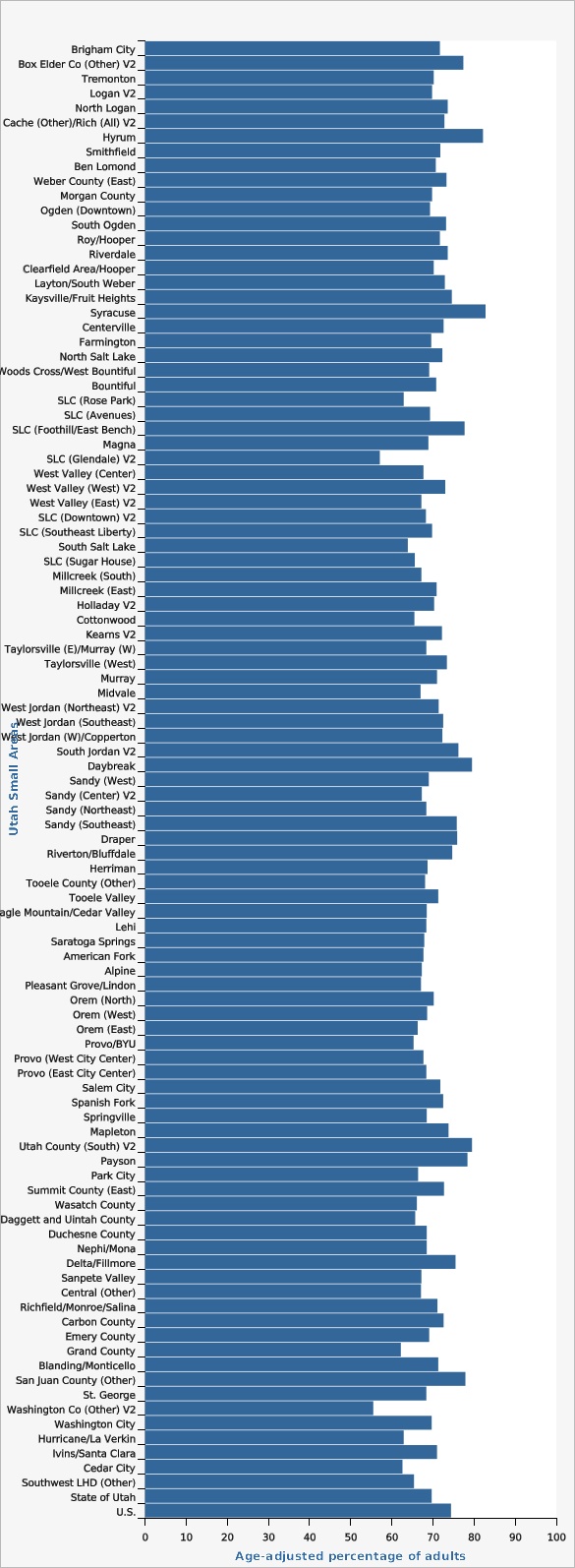Complete Health Indicator Report of Routine Medical Care Visits
Definition
Percentage of Utah adults who reported a routine check-up in the past year.Numerator
Number of survey respondents who reported a routine check-up in the past year.Denominator
Total number of survey respondents excluding those with missing, "Don't know/Not sure," and "Refused" responses.Data Interpretation Issues
Question Text: "About how long has it been since you last visited a doctor for a routine checkup? A routine checkup is a general physical exam, not an exam for a specific injury, illness, or condition." Beginning in 2011, BRFSS data include both landline and cell phone respondent data along with a new weighting methodology called iterative proportional fitting, or raking. This methodology utilizes additional demographic information (such as education, race, and marital status) in the weighting procedure. Both of these methodology changes were implemented to account for an increased number of U.S. households without landline phones and an under-representation of certain demographic groups that were not well-represented in the sample. More details about these changes can be found at: [https://ibis.health.utah.gov/pdf/opha/resource/brfss/RakingImpact2011.pdf]. As with all surveys, some error results from nonresponse (e.g., refusal to participate in the survey or to answer specific questions) and measurement (e.g., social desirability or recall bias). Error was minimized by use of strict calling protocols (up to 15 calls were made to reach each household), good questionnaire design, standardization of interviewer behavior, interviewer training, and frequent, on-site interviewer monitoring and supervision.Why Is This Important?
Clinical preventive services are important for maintaining good health. Early detection and treatment of disease improve the chances of full recovery. Physician counseling can influence health behaviors and prevent disease entirely in many cases. It is especially important for persons in poor health to have a primary physician who understands their medical history and problems and can give them appropriate care that fits their medical and social context.How Are We Doing?
In 2022, 70.2% of Utah adults reported having a routine check-up within the past 12 months (age-adjusted rate).How Do We Compare With the U.S.?
Nationally, the rate of recent doctor visits is higher than in Utah. Comparing age-adjusted rates for 2022, 74.4% of U.S. adults had a routine check-up in the past year, whereas 70.2% of Utah adults had a checkup in the past year.What Is Being Done?
The Utah Department of Health and Human Services administers programs to improve access to care, such as Medicaid, Children's Health Insurance Program (CHIP), Utah's Premium Partnership for Health Insurance (UPP), and clinics for children with disabilities. Local health departments provide preventive services such as immunizations and screenings at low or no cost to persons who cannot otherwise afford them.Available Services
Utah Medicaid Program: phone 1-800-662-9651, or visit [https://medicaid.utah.gov/] Utah Children's Health Insurance Program (CHIP): [[br]] phone 1-877-KIDS-NOW (1-877-543-7669) or visit [https://chip.health.utah.gov/] UPP (Utah's Premium Partnership for Health Insurance):[[br]] phone: 1-888-222-2542 (M - F, 8 a.m. - 5 p.m.) [[br]] or visit [https://medicaid.utah.gov/upp/] The Association for Utah Community Health (AUCH) is the primary care association for the state of Utah. AUCH members include Federally Qualified Health Centers (FQHC) and other providers who strive to meet the needs of the medically underserved. AUCH and its member organizations are part of a statewide and national movement to reduce barriers to health care by enhancing primary care service delivery through prevention, health promotion, and community participation. Association for Utah Community Health[[br]] 860 East 4500 South[[br]] Salt Lake City, UT 84107[[br]] Phone: (801) 974-5522 [[br]] [http://www.auch.org]Related Indicators
Relevant Population Characteristics
In 2022, among adults, women (74.3%) had a higher age-adjusted rate of having a routine check-up in the past 12 months than men (66.2%). This difference is a result presumably of childbearing and other reproductive health-related issues. Older Utahns aged 65 and over, who are at greater risk for a chronic medical condition, were more likely to report a routine check-up (92.3% in 2022) than were younger adults.Related Relevant Population Characteristics Indicators:
Graphical Data Views
| Males vs. Females | Age Group | Percentage of adults | Lower Limit | Upper Limit | ||
|---|---|---|---|---|---|---|
Record Count: 10 | ||||||
| Male | 18-34 | 51.3% | 47.9% | 54.8% | ||
| Male | 35-49 | 61.9% | 58.5% | 65.1% | ||
| Male | 50-64 | 73.7% | 70.2% | 76.9% | ||
| Male | 65+ | 91.4% | 89.1% | 93.3% | ||
| Female | 18-34 | 65.7% | 62.0% | 69.2% | ||
| Female | 35-49 | 69.4% | 66.0% | 72.5% | ||
| Female | 50-64 | 78.6% | 75.5% | 81.4% | ||
| Female | 65+ | 93.1% | 91.3% | 94.5% | ||
Data Source
Utah Department of Health and Human Services Behavioral Risk Factor Surveillance System (BRFSS) [https://ibis.health.utah.gov/ibisph-view/query/selection/brfss/BRFSSSelection.html]| Health status | Age-adjusted percentage of adults | Lower Limit | Upper Limit | |||
|---|---|---|---|---|---|---|
Record Count: 2 | ||||||
| Fair/poor | 72.7% | 69.1% | 75.9% | |||
| Good/very good/excellent | 69.8% | 68.5% | 71.0% | |||
Data Notes
Age-adjusted to the U.S. 2000 standard population.Data Source
Utah Department of Health and Human Services Behavioral Risk Factor Surveillance System (BRFSS) [https://ibis.health.utah.gov/ibisph-view/query/selection/brfss/BRFSSSelection.html]| Insurance Status | Age-adjusted percentage of adults | Lower Limit | Upper Limit | |||
|---|---|---|---|---|---|---|
Record Count: 2 | ||||||
| Have insurance | 72.7% | 71.5% | 73.9% | |||
| Do not have insurance | 43.2% | 36.5% | 50.2% | |||
Data Notes
Age-adjusted to the U.S. 2000 standard population.Data Source
Utah Department of Health and Human Services Behavioral Risk Factor Surveillance System (BRFSS) [https://ibis.health.utah.gov/ibisph-view/query/selection/brfss/BRFSSSelection.html]| Hispanic Ethnicity | Age-adjusted percentage of adults | Lower Limit | Upper Limit | |||
|---|---|---|---|---|---|---|
Record Count: 4 | ||||||
| Hispanic/Latino | 66.6% | 63.5% | 69.6% | |||
| Non-Hispanic/Latino | 70.9% | 69.6% | 72.2% | |||
| All ethnicities | 70.2% | 69.0% | 71.3% | |||
| U.S. | 74.4% | 74.1% | 74.7% | |||
Data Notes
Age-adjusted to the U.S. 2000 standard population.Data Sources
- Utah Department of Health and Human Services Behavioral Risk Factor Surveillance System (BRFSS) [https://ibis.health.utah.gov/ibisph-view/query/selection/brfss/BRFSSSelection.html]
- Behavioral Risk Factor Surveillance System Survey Data, US Department of Health and Human Services Centers for Disease Control and Prevention (CDC).
| Race | Age-adjusted percentage of adults | Lower Limit | Upper Limit | |||
|---|---|---|---|---|---|---|
Record Count: 7 | ||||||
| American Indian/Alaska Native | 70.3% | 64.7% | 75.3% | |||
| Asian | 70.0% | 64.7% | 74.8% | |||
| Black, African American | 70.6% | 64.5% | 76.0% | |||
| Native Hawaiian, Pacific Islander | 64.4% | 54.7% | 73.1% | |||
| White | 69.9% | 69.2% | 70.6% | |||
| All races | 69.5% | 68.8% | 70.2% | |||
| U.S. | 73.2% | 73.1% | 73.4% | |||
Data Notes
Age-adjusted to the U.S. 2000 standard population based on 3 age groups: 18-34, 35-49, and 50+.Data Sources
- Utah Department of Health and Human Services Behavioral Risk Factor Surveillance System (BRFSS) [https://ibis.health.utah.gov/ibisph-view/query/selection/brfss/BRFSSSelection.html]
- Behavioral Risk Factor Surveillance System Survey Data, US Department of Health and Human Services Centers for Disease Control and Prevention (CDC).
| Local Health District | Age-adjusted percentage of adults | Lower Limit | Upper Limit | |||
|---|---|---|---|---|---|---|
Record Count: 15 | ||||||
| Bear River | 74.3% | 70.1% | 78.1% | |||
| Central | 66.7% | 60.2% | 72.6% | |||
| Davis County | 72.5% | 68.4% | 76.2% | |||
| Salt Lake County | 70.3% | 68.1% | 72.4% | |||
| San Juan | 75.9% | 60.5% | 86.6% | |||
| Southeast | 70.1% | 62.4% | 76.7% | |||
| Southwest | 71.1% | 66.6% | 75.2% | |||
| Summit | 70.1% | 60.0% | 78.6% | |||
| Tooele | 69.1% | 62.8% | 74.6% | |||
| TriCounty | 65.4% | 58.0% | 72.2% | |||
| Utah County | 68.4% | 65.8% | 70.8% | |||
| Wasatch | 62.7% | 53.5% | 71.0% | |||
| Weber-Morgan | 73.8% | 70.0% | 77.3% | |||
| State of Utah | 70.3% | 69.1% | 71.5% | |||
| U.S. | 74.4% | 74.1% | 74.7% | |||
Data Notes
Age-adjusted to the U.S. 2000 standard population. Note: At the time of this update, the BRFSS U.S. dataset did not include an age variable but did include five age categories up to age 80+ (vs. the typical weighting scheme that includes 85+). Comparisons with both weighting schemes were compared using Utah data, and the difference was about 1/100 of a percentage point.Data Sources
- Utah Department of Health and Human Services Behavioral Risk Factor Surveillance System (BRFSS) [https://ibis.health.utah.gov/ibisph-view/query/selection/brfss/BRFSSSelection.html]
- Behavioral Risk Factor Surveillance System Survey Data, US Department of Health and Human Services Centers for Disease Control and Prevention (CDC).
| Utah Small Areas | Age-adjusted percentage of adults | Lower Limit | Upper Limit | Note | ||
|---|---|---|---|---|---|---|
Record Count: 101 | ||||||
| Brigham City | 71.7% | 64.3% | 78.1% | |||
| Box Elder Co (Other) V2 | 77.4% | 68.1% | 84.6% | |||
| Tremonton | 70.2% | 61.4% | 77.6% | |||
| Logan V2 | 69.8% | 64.8% | 74.4% | |||
| North Logan | 73.6% | 66.6% | 79.6% | |||
| Cache (Other)/Rich (All) V2 | 72.8% | 65.2% | 79.2% | |||
| Hyrum | 82.2% | 70.0% | 90.1% | * | ||
| Smithfield | 71.8% | 63.5% | 78.9% | |||
| Ben Lomond | 70.7% | 65.9% | 75.1% | |||
| Weber County (East) | 73.3% | 66.7% | 79.0% | |||
| Morgan County | 69.8% | 58.3% | 79.2% | |||
| Ogden (Downtown) | 69.3% | 63.6% | 74.5% | |||
| South Ogden | 73.2% | 67.4% | 78.4% | |||
| Roy/Hooper | 71.7% | 66.0% | 76.7% | |||
| Riverdale | 73.6% | 65.1% | 80.7% | |||
| Clearfield Area/Hooper | 70.2% | 64.8% | 75.1% | |||
| Layton/South Weber | 72.9% | 68.4% | 77.0% | |||
| Kaysville/Fruit Heights | 74.6% | 67.8% | 80.3% | |||
| Syracuse | 82.8% | 76.7% | 87.5% | |||
| Centerville | 72.6% | 61.9% | 81.2% | |||
| Farmington | 69.6% | 60.6% | 77.3% | |||
| North Salt Lake | 72.3% | 62.6% | 80.2% | |||
| Woods Cross/West Bountiful | 69.1% | 60.4% | 76.6% | |||
| Bountiful | 70.8% | 64.9% | 76.1% | |||
| SLC (Rose Park) | 62.9% | 55.3% | 69.9% | |||
| SLC (Avenues) | 69.3% | 59.9% | 77.3% | |||
| SLC (Foothill/East Bench) | 77.7% | 67.8% | 85.3% | |||
| Magna | 68.9% | 62.0% | 75.0% | |||
| SLC (Glendale) V2 | 57.1% | 47.9% | 65.8% | |||
| West Valley (Center) | 67.7% | 61.2% | 73.5% | |||
| West Valley (West) V2 | 73.0% | 65.5% | 79.4% | |||
| West Valley (East) V2 | 67.2% | 61.2% | 72.8% | |||
| SLC (Downtown) V2 | 68.3% | 62.0% | 74.1% | |||
| SLC (Southeast Liberty) | 69.8% | 61.3% | 77.1% | |||
| South Salt Lake | 63.9% | 55.8% | 71.2% | |||
| SLC (Sugar House) | 65.6% | 59.0% | 71.7% | |||
| Millcreek (South) | 67.2% | 57.0% | 76.0% | |||
| Millcreek (East) | 70.9% | 62.7% | 77.9% | |||
| Holladay V2 | 70.3% | 58.6% | 79.8% | |||
| Cottonwood | 65.5% | 58.4% | 71.9% | |||
| Kearns V2 | 72.2% | 65.8% | 77.9% | |||
| Taylorsville (E)/Murray (W) | 68.4% | 61.9% | 74.3% | |||
| Taylorsville (West) | 73.4% | 67.3% | 78.7% | |||
| Murray | 71.0% | 64.6% | 76.7% | |||
| Midvale | 67.0% | 59.6% | 73.6% | |||
| West Jordan (Northeast) V2 | 71.4% | 63.7% | 78.0% | |||
| West Jordan (Southeast) | 72.5% | 65.9% | 78.2% | |||
| West Jordan (W)/Copperton | 72.3% | 65.7% | 78.1% | |||
| South Jordan V2 | 76.2% | 69.6% | 81.7% | |||
| Daybreak | 79.5% | 72.9% | 84.7% | |||
| Sandy (West) | 69.0% | 60.4% | 76.4% | |||
| Sandy (Center) V2 | 67.3% | 58.9% | 74.7% | |||
| Sandy (Northeast) | 68.4% | 57.7% | 77.5% | |||
| Sandy (Southeast) | 75.8% | 68.4% | 82.0% | |||
| Draper | 75.9% | 69.8% | 81.1% | |||
| Riverton/Bluffdale | 74.7% | 68.9% | 79.8% | |||
| Herriman | 68.7% | 62.6% | 74.2% | |||
| Tooele County (Other) | 68.1% | 59.9% | 75.4% | |||
| Tooele Valley | 71.3% | 67.2% | 75.0% | |||
| Eagle Mountain/Cedar Valley | 68.5% | 62.1% | 74.3% | |||
| Lehi | 68.4% | 63.9% | 72.6% | |||
| Saratoga Springs | 67.9% | 61.4% | 73.8% | |||
| American Fork | 67.7% | 62.4% | 72.6% | |||
| Alpine | 67.3% | 53.2% | 78.9% | |||
| Pleasant Grove/Lindon | 67.1% | 62.0% | 71.8% | |||
| Orem (North) | 70.2% | 63.7% | 76.0% | |||
| Orem (West) | 68.6% | 62.9% | 73.8% | |||
| Orem (East) | 66.3% | 58.2% | 73.6% | |||
| Provo/BYU | 65.3% | 59.1% | 70.9% | |||
| Provo (West City Center) | 67.7% | 60.9% | 73.8% | |||
| Provo (East City Center) | 68.4% | 60.6% | 75.3% | |||
| Salem City | 71.8% | 58.9% | 81.9% | |||
| Spanish Fork | 72.5% | 66.6% | 77.8% | |||
| Springville | 68.5% | 61.9% | 74.4% | |||
| Mapleton | 73.8% | 62.0% | 83.0% | |||
| Utah County (South) V2 | 79.5% | 70.7% | 86.2% | |||
| Payson | 78.4% | 72.0% | 83.7% | |||
| Park City | 66.4% | 59.3% | 72.8% | |||
| Summit County (East) | 72.7% | 64.7% | 79.5% | |||
| Wasatch County | 66.1% | 60.4% | 71.3% | |||
| Daggett and Uintah County | 65.7% | 60.9% | 70.1% | |||
| Duchesne County | 68.5% | 62.5% | 73.8% | |||
| Nephi/Mona | 68.5% | 56.6% | 78.3% | |||
| Delta/Fillmore | 75.5% | 66.4% | 82.7% | |||
| Sanpete Valley | 67.2% | 60.1% | 73.5% | |||
| Central (Other) | 67.1% | 60.9% | 72.8% | |||
| Richfield/Monroe/Salina | 71.1% | 64.0% | 77.3% | |||
| Carbon County | 72.6% | 66.9% | 77.7% | |||
| Emery County | 69.1% | 60.2% | 76.8% | |||
| Grand County | 62.2% | 53.4% | 70.2% | |||
| Blanding/Monticello | 71.3% | 61.5% | 79.4% | |||
| San Juan County (Other) | 77.9% | 65.9% | 86.6% | |||
| St. George | 68.4% | 63.8% | 72.8% | |||
| Washington Co (Other) V2 | 55.5% | 44.9% | 65.6% | |||
| Washington City | 69.7% | 60.7% | 77.3% | |||
| Hurricane/La Verkin | 62.9% | 54.3% | 70.8% | |||
| Ivins/Santa Clara | 71.0% | 58.8% | 80.8% | |||
| Cedar City | 62.6% | 56.3% | 68.5% | |||
| Southwest LHD (Other) | 65.4% | 57.6% | 72.4% | |||
| State of Utah | 69.7% | 69.0% | 70.3% | |||
| U.S. | 74.4% | 74.1% | 74.7% | |||
Data Notes
Age-adjusted to the 2000 U.S. standard population. *Use caution in interpreting; the estimate has a coefficient of variation >30% and is therefore deemed unreliable by Utah Department of Health and Human Services standards. A description of the Utah Small Areas may be found on IBIS at the following URL: [https://ibis.health.utah.gov/resource/Guidelines.html].Data Sources
- Behavioral Risk Factor Surveillance System Survey Data, US Department of Health and Human Services Centers for Disease Control and Prevention (CDC).
- Utah Department of Health and Human Services Behavioral Risk Factor Surveillance System (BRFSS) [https://ibis.health.utah.gov/ibisph-view/query/selection/brfss/BRFSSSelection.html]
| BRFSS Utah vs. U.S. | Year | Age-adjusted percentage of adults | Lower Limit | Upper Limit | ||
|---|---|---|---|---|---|---|
Record Count: 34 | ||||||
| UT Old Methodology | 2007 | 55.9% | 54.1% | 57.6% | ||
| UT Old Methodology | 2008 | 57.0% | 55.2% | 58.7% | ||
| UT Old Methodology | 2009 | 58.6% | 57.3% | 59.9% | ||
| UT Old Methodology | 2010 | 59.9% | 58.6% | 61.2% | ||
| US Old Methodology | 2007 | 67.3% | 67.0% | 67.6% | ||
| US Old Methodology | 2008 | 67.7% | 67.4% | 68.1% | ||
| US Old Methodology | 2009 | 67.8% | 67.5% | 68.1% | ||
| US Old Methodology | 2010 | 66.9% | 66.6% | 67.2% | ||
| UT New Methodology | 2009 | 58.1% | 56.8% | 59.3% | ||
| UT New Methodology | 2010 | 58.2% | 57.1% | 59.3% | ||
| UT New Methodology | 2011 | 57.1% | 56.0% | 58.2% | ||
| UT New Methodology | 2012 | 58.3% | 57.1% | 59.4% | ||
| UT New Methodology | 2013 | 58.7% | 57.6% | 59.8% | ||
| UT New Methodology | 2014 | 59.0% | 58.0% | 59.9% | ||
| UT New Methodology | 2015 | 60.0% | 58.8% | 61.1% | ||
| UT New Methodology | 2016 | 62.2% | 61.0% | 63.4% | ||
| UT New Methodology | 2017 | 61.2% | 60.0% | 62.4% | ||
| UT New Methodology | 2018 | 69.8% | 68.7% | 70.9% | ||
| UT New Methodology | 2019 | 69.7% | 68.6% | 70.8% | ||
| UT New Methodology | 2020 | 68.9% | 67.7% | 70.0% | ||
| UT New Methodology | 2021 | 69.9% | 68.8% | 71.0% | ||
| UT New Methodology | 2022 | 70.2% | 69.0% | 71.3% | ||
| US New Methodology | 2011 | 66.0% | 65.7% | 66.3% | ||
| US New Methodology | 2012 | 67.4% | 67.1% | 67.7% | ||
| US New Methodology | 2013 | 67.6% | 67.3% | 67.9% | ||
| US New Methodology | 2014 | 68.8% | 68.5% | 69.1% | ||
| US New Methodology | 2015 | 68.6% | 64.3% | 72.9% | ||
| US New Methodology | 2016 | 70.0% | 69.7% | 70.2% | ||
| US New Methodology | 2017 | 69.2% | 68.9% | 69.5% | ||
| US New Methodology | 2018 | 75.3% | 75.0% | 75.6% | ||
| US New Methodology | 2019 | 75.1% | 74.8% | 75.4% | ||
| US New Methodology | 2020 | 73.2% | 72.8% | 73.5% | ||
| US New Methodology | 2021 | 72.0% | 71.7% | 72.4% | ||
| US New Methodology | 2022 | 74.4% | 74.1% | 74.7% | ||
Data Notes
Age-adjusted to U.S. 2000 standard population. U.S. data are the average for all states and the District of Columbia but do not include the U.S. territories. Starting in 2009, the BRFSS included both landline and cell phone respondent interviews along with a new weighting methodology called iterative proportional fitting, or raking. More details about these changes can be found at: [https://ibis.health.utah.gov/pdf/opha/resource/brfss/RakingImpact2011.pdf]. Note: At the time of this update, the BRFSS U.S. dataset did not include an age variable but did include five age categories up to age 80+ (vs. the typical weighting scheme that includes 85+). Comparisons with both weighting schemes were compared using Utah data, and the difference was about 1/100 of a percentage point.Data Sources
- Utah Department of Health and Human Services Behavioral Risk Factor Surveillance System (BRFSS) [https://ibis.health.utah.gov/ibisph-view/query/selection/brfss/BRFSSSelection.html]
- Behavioral Risk Factor Surveillance System Survey Data, US Department of Health and Human Services Centers for Disease Control and Prevention (CDC).
More Resources and Links
Evidence-based community health improvement ideas and interventions may be found at the following sites:Additional indicator data by state and county may be found on these Websites:
- CDC Prevention Status Reports for all 50 states
- County Health Rankings
- Kaiser Family Foundation's StateHealthFacts.org
- CDC WONDER DATA2010, the Healthy People 2010 Database.
Medical literature can be queried at the PubMed website.
Page Content Updated On 03/08/2024,
Published on 04/17/2024





